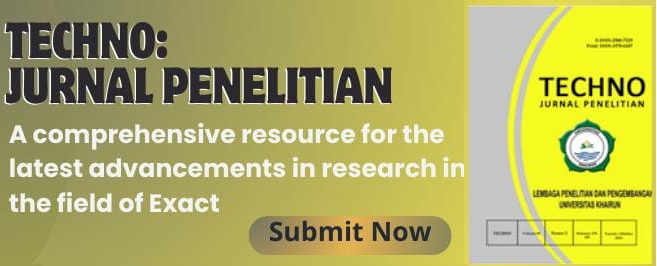Coconut Waste Pyrolysis Simulation Using Aspen Plus Software
Abstract
Currently, in the world are trying to substitute fossil energy for renewable energy. One of the renewable energy is biomass energy. Biomass is a renewable natural resource derived from biological nature. Biomass from palm shells has been successfully used by the Tembilahan PLTU as an effort to substitute coal. The results of technical evaluation and monitoring show operating parameters within normal limits. Palm shells are known to have a lower sulfur content than coal so that the emissions produced are less than coal. When viewed from the characteristics based on the analysis of proximate, ultimate and calorific value, it shows that the characteristics of biomass from coconut waste, especially coconut shells, are not significantly different from biomass from palm shells. This means that coconut shells can be considered as a renewable energy source. To improve the quality of the calorific value of biomass, a pyrolysis process is carried out to produce bio-charcoal. Modeling using Aspen Plus software has a difference average of less than 6%. Simulation results of coconut shell pyrolysis with maximum yield of bio-charcoal occurring at an operating temperature of 600°C which produces a total of 30.35% bio-charcoal, a calorific value (LHV) of 33.03 MJ/kg, and an ash content of 18.99%. While the simulation results of coconut shell pyrolysis with maximum syngas yield occurred at an operating temperature of 800°C which produced 82.43% syngas, high H2 49.67% and low CO2 2.90%.
Keywords
Full Text:
PDFReferences
Alnouss, A., Mckay, G., & Al-Ansari, T. (2018). Optimum Utilization of Biomass for the Production of Power and Fuels using Gasification. Computer-Aided Chemical Engineering, 43, 1481-1486. http://dx.doi.org/10.1016/B978-0-444-64235-6.50258-8
AlNouss, A., Parthasarathy, P., Mackey, H. R., Al-Ansari, T., & McKay, G. (2021). Pyrolysis Study of Different Fruit Wastes using an Aspen Plus Model. Frontiers in Sustainable Food Systems, 5, 604001. https://doi.org/10.3389/fsufs.2021.604001
Choi, H. S., Choi, Y. S., & Park, H. C. (2012). Fast Pyrolysis Characteristics of Lignocellulosic Biomass with Varying Reaction Conditions. Renewable Energy, 42, 131-135. https://doi.org/10.1016/j.renene.2011.08.049
Dewan Energi Nasional. (2020). Buku Bauran Energi Nasional. Jakarta: Sekretariat Jenderal Dewan Energi Nasional Republik Indonesia
Direktorat Jenderal Perkebunan. (2020). Luas Areal Kelapa Menurut Provinsi di Indonesia 2017-2021. Jakarta: Direktorat Jenderal Perkebunan
Dufour, A., Girods, P., Masson, E., Rogaume, Y., & Zoulalian, A. (2009). Synthesis Gas Production by Biomass Pyrolysis: Effect of Reactor Temperature on Product Distribution. International Journal of Hydrogen Energy, 34(4), 1726-1734. https://doi.org/10.1016/j.ijhydene.2008.11.075
Elkhalifa, S., AlNouss, A., Al-Ansari, T., Mackey, H. R., Parthasarathy, P., & Mckay, G. (2019). Simulation of Food Waste Pyrolysis for The Production of Biochar: A Qatar Case Study. In Computer Aided Chemical Engineering (Vol. 46, pp. 901-906). Elsevier. https://doi.org/10.1016/B978-0-12-818634-3.50151-X
Ismail, H. Y., Abbas, A., Azizi, F., & Zeaiter, J. (2017). Pyrolysis of Waste Tires: A Modeling and Parameter Estimation Study Using Aspen Plus. Waste management, 60, 482-493. https://doi.org/10.1016/j.wasman.2016.10.024
Kabir, M., Chowdhury, A., & Rasul, M. (2015). Pyrolysis of municipal green waste: A Modelling, Simulation and Experimental Analysis. Energies, 8, 7522–7541. https://doi.org/10.3390/en8087522
Sajdak, M., Kmieć, M., Micek, B., & Hrabak, J. (2019). Determination of The Optimal Ratio of Coal to Biomass in The Co-Firing Process: Feed Mixture Properties. International journal of Environmental science and technology, 16(7), 2989-3000. https://doi.org/10.1007/s13762-018-1864-y
Liu, Y., Yang, X., Zhang, J., & Zhu, Z. (2022). Process Simulation of Preparing Biochar by Biomass Pyrolysis via Aspen Plus and Its Economic Evaluation. Waste and Biomass Valorization, 13, 2609–2622, https://doi.org/10.1007/s12649-021-01671-z
Lv, P. M., Xiong, Z. H., Chang, J., Wu, C. Z., Chen, Y., & Zhu, J. X. (2004). An Experimental Study on Biomass Air–Steam Gasification in a Fluidized Bed. Bioresource Technology, 95(1), 95-101. https://doi.org/10.1016/j.biortech.2004.02.003
Menon, S. D., Sampath, K., & Kaarthik, S. S. (2021). Feasibility Studies of Coconut Shells Biomass for Downdraft Gasification. Materials Today: Proceedings, 44, 3133-3137. https://doi.org/10.1016/j.matpr.2021.02.813
Najib, L., & Darsopuspito, S. (2012). Karakterisasi Proses Gasifikasi Biomassa Tempurung Kelapa Sistem Downdraft Kontinyu dengan Variasi Perbandingan Udara-Bahan Bakar (AFR) dan Ukuran Biomassa. Jurnal Teknik ITS, 1(1), B187-B190. http://dx.doi.org/10.12962/j23373539.v1i1.1837
Novita, S. A., Santosa., Nofialdi., Andasuryani., dan Fudholi, A., 2021, Artikel Review: Parameter Operasional Pirolisis Biomassa, Agroteknika, 4(1), 53-67. https://doi.org/10.32530/agroteknika.v4i1.105
Nurhayati, F. (2022). Menuju Energi Hijau, Sukses Uji HCR 100% Biomassa PLTU Tembilahan. Surabaya: Info PJB Edisi 131.
Paulauskas, R., Džiugys, A., Striūgas, N., Garšvinskaitė, L., & Misiulis, E. (2014). Experimental and Theoretical Investigation of Wood Pellet Shrinkage During Pyrolysis. Energetika, 60(1), 1–11. https://doi.org/10.6001/energetika.v60i1.2867
Ridhuan, K., & Irawan, D. (2019). Pengaruh Jenis Biomassa Terhadap Karaktristik Pembakaran dan Hasil Bioarang Asap Cair dari Proses Pirolisis. Mechanical, 10(1), 7-14. http://dx.doi.org/10.23960/mech.v10.i1.201902
Ridhuan, K., Irawan, D., Zanaria, Y., & Firmansyah, F. (2019). Pengaruh Jenis Biomassa pada Pembakaran Pirolisis terhadap Karakteristik dan Efisiensibioarang-Asap Cair yang Dihasilkan. Media Mesin: Majalah Teknik Mesin, 20(1), 18-27. https://doi.org/10.23917/mesin.v20i1.7976
Simpala, M.M., & Kusuma, A. (2017). Kelapa-Mengembalikan Kejayaan Kelapa Indonesia, Edisi I. Yogyakarta: Lily Publisher
Sugiyanto. (2021). Efisiensi Pembangkit di Era Industri 4.0. Webinar ESDM Efisiensi Penyediaan Tenaga Listrik, PTPJB Indonesia
Tursi, A. (2019). A Review on Biomass: Importance, Chemistry, Classification, and Conversion. Biofuel Research Journal, 6(2), 962–979. https://doi.org/10.18331/BRJ2019.6.2.3
Wang, S., Dai, G., Yang, H., & Luo, Z. (2017). Lignocellulosic Biomass Pyrolysis Mechanism: A State-of-The-Art Review. Progress in Energy and Combustion Science, 62, 33-86. https://doi.org/10.1016/j.pecs.2017.05.004
Zojec, L. (2009). Slow Pyrolysis in Rotary Kiln Reactor: Optimization and Experiments. Iceland: University of Iceland and The University of Akureyri.
Zhang, L., Xu, C. C., & Champagne, P. (2010). Overview of Recent Advances in Thermo-Chemical Conversion of Biomass. Energy Conversion and Management, 51(5), 969-982. https://doi.org/10.1016/j.enconman.2009.11.038
DOI: https://doi.org/10.33387/tjp.v12i1.5263
Refbacks
- There are currently no refbacks.
Copyright (c) 2023 Muhammad Syukri Hasan, Widayat Widayat, Sri Widodo Agung Suedi

This work is licensed under a Creative Commons Attribution-NonCommercial 4.0 International License.
-------------------------------------------------------------------------------------------------------------------------------------------------------------------
-------------------------------------------------------------------------------------------------------------------------------------------------------------------
TECHNO: Jurnal Penelitian
Published by: LPPM Universitas Khairun
Addres : Jalan Yusuf Abdurrahman Kampus II Unkhair, Kelurahan Gambesi, 97722 Kecamatan Kota Ternate Selatan, Provinsi Maluku Utara, Email: techno@unkhair.ac.id | URL: http://ejournal.unkhair.ac.id/index.php/Techno
Techno Jurnal Penelitian is licensed under a Creative Commons Attribution-NonCommercial 4.0 International License.


























